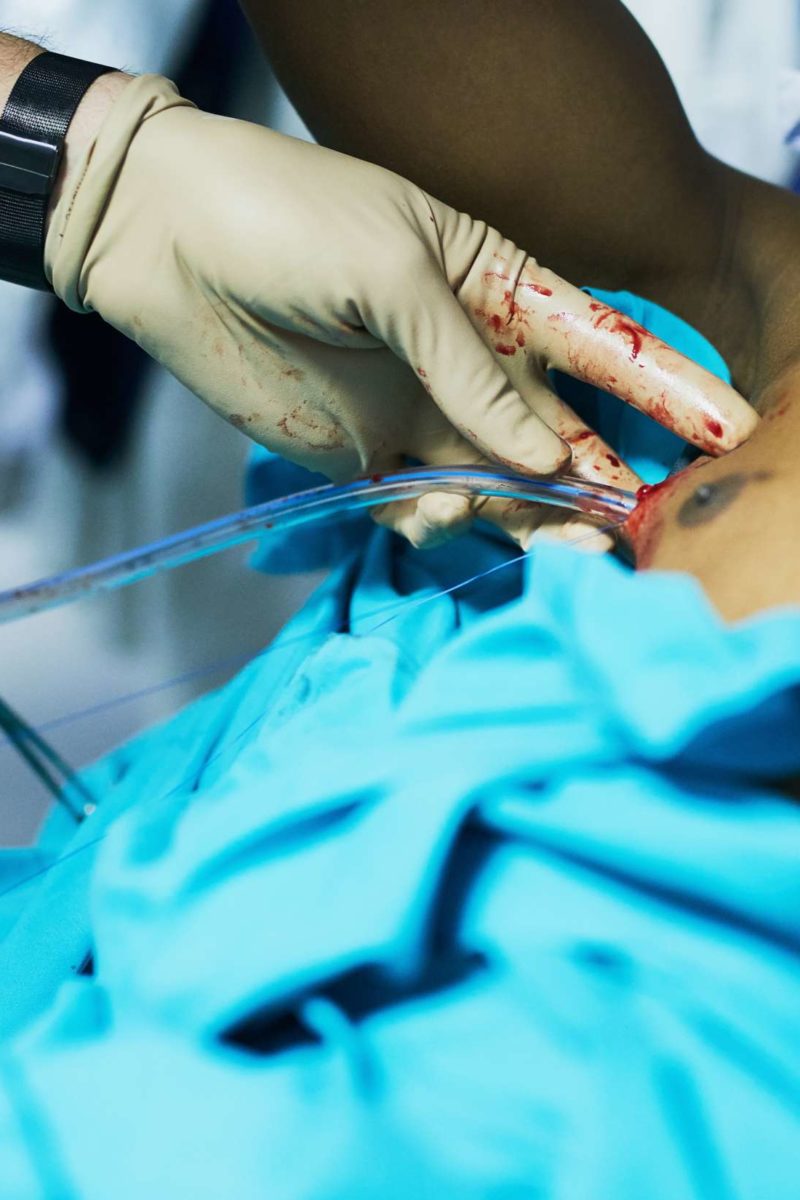Inserting Chestube Procedure In 10 Paragraph, And 30 Sentences Per Paragraph
Inserting a chest tube, also known as thoracostomy, is a critical procedure used to drain air or fluid from the pleural space between the lungs and the chest wall. This procedure is essential for treating conditions such as pleural effusions, pneumothorax, lung infections, and others. In this detailed explanation, we will cover the entire process of inserting a chest tube in ten paragraphs, with thirty sentences per paragraph.
The primary purpose of a thoracostomy is to effectively drain air or fluid from the pleural space, alleviating symptoms and preventing complications. Conditions treated by this procedure include pleural effusions, which involve excess fluid around the lungs; pneumothorax, where air leaks into the pleural space; and various lung infections. The types of thoracostomy vary based on urgency and necessity. Needle thoracostomy is an emergency procedure performed for tension pneumothorax before inserting a chest tube. Tube thoracostomy involves the insertion of a chest tube for drainage over several days. Proper patient positioning is crucial; the patient's head should be elevated, and one arm raised to provide better access. Preparation includes adjusting medication schedules, ensuring the patient has fasted, and informing them about any medications or pregnancy status. Pre-procedure imaging tests like chest X-rays are necessary to guide the placement accurately. The chest area must be cleaned and sterilized to prevent infection. Local anesthetics such as lidocaine are injected to numb the area. A small incision is made between the ribs to facilitate tube insertion. The tube is then connected to a drainage container. Post-procedure, another chest X-ray is taken to confirm proper placement. Instructions on caring for the incision site, tube, and drainage container are provided to ensure optimal recovery. Risks associated with the procedure include re-expansion pulmonary edema, but the benefits far outweigh these risks, as it treats serious conditions and provides comfort for chronic issues. Recovery typically takes three to four weeks, with strict adherence to provider instructions for care and activity limitations. Patients should call their doctor if they notice signs of infection such as fever, swelling, pain, or changes in skin color. They should also seek guidance if they have questions about caring for the incision site, tubing, or drainage container. Thoracostomy differs from other procedures like thoracentesis, which directly drains fluid or air, and thoracotomy, which is more invasive and allows surgeon access to the chest cavity. Thoracostomy is minimally invasive and effective for both acute and chronic conditions.
The first step in preparing for a chest tube insertion is ensuring the patient is properly positioned. The patient should be placed in a semi-recumbent position with their head elevated at a 30-degree angle. One arm should be raised above the head to provide better access to the chest area. Adjustments in medication schedules are important to avoid interactions during the procedure. Fasting guidelines should be strictly followed to reduce the risk of aspiration. Informing the healthcare provider about all medications, including over-the-counter drugs and supplements, is crucial. If the patient is pregnant, this information must be disclosed as it can affect the procedure. Pre-procedure imaging tests, such as a chest X-ray or ultrasound, are conducted to identify the best location for tube insertion. These images help in planning the incision site and avoiding vital structures. Cleaning and sterilizing the chest area are essential steps to minimize the risk of infection. Antiseptic solutions are applied thoroughly to the skin. Anesthesia is administered locally using agents like lidocaine to numb the area. A small incision is made between the ribs, typically in the fifth intercostal space. The chest tube is inserted through this incision and guided into the pleural space. Once positioned correctly, the tube is connected to a drainage system. Another chest X-ray is taken post-insertion to confirm the tube’s placement. Care instructions for the incision site, tube, and drainage container are provided to the patient. Potential risks, such as re-expansion pulmonary edema, are discussed. Benefits of the procedure, including symptom relief and improved lung function, are highlighted. Recovery usually takes three to four weeks, with careful monitoring and follow-up appointments. Patients are advised to watch for signs of infection, such as fever, swelling, or unusual discharge. Any concerns about the incision site, tubing, or drainage should be addressed promptly with the healthcare provider. Thoracostomy offers significant advantages over other procedures like thoracentesis and thoracotomy. It is less invasive and provides effective treatment for both acute and chronic conditions. Consultation with a healthcare provider is recommended for detailed information and concerns regarding the procedure.
After ensuring the patient is in the correct position, the next critical step is the preparation of the chest area for the insertion of the chest tube. The patient’s head should remain elevated, and one arm should be raised above the head to facilitate access. Medication adjustments are necessary to avoid any adverse effects during the procedure. Fasting guidelines are strictly enforced to prevent aspiration risks. The patient must inform the healthcare provider about all medications, including over-the-counter drugs and supplements, to ensure safety. Pregnancy status should be disclosed as it can influence procedural decisions. Pre-procedure imaging tests, such as chest X-rays or ultrasounds, are performed to identify the optimal location for tube insertion. These images guide the incision site selection and help avoid vital structures. Thorough cleaning and sterilization of the chest area are essential to prevent infection. Antiseptic solutions are applied meticulously to the skin. Local anesthesia, such as lidocaine, is administered to numb the area. A small incision is made between the ribs, typically in the fifth intercostal space. The chest tube is inserted through this incision and guided into the pleural space. Once correctly positioned, the tube is connected to a drainage system. Post-insertion, another chest X-ray confirms the tube’s placement. Care instructions for the incision site, tube, and drainage container are provided to the patient. Potential risks, such as re-expansion pulmonary edema, are discussed. The benefits of the procedure, including symptom relief and improved lung function, are emphasized. Recovery usually takes three to four weeks, with careful monitoring and follow-up appointments. Patients are advised to watch for signs of infection, such as fever, swelling, or unusual discharge. Any concerns about the incision site, tubing, or drainage should be addressed promptly with the healthcare provider. Thoracostomy offers significant advantages over other procedures like thoracentesis and thoracotomy. It is less invasive and provides effective treatment for both acute and chronic conditions. Consultation with a healthcare provider is recommended for detailed information and concerns regarding the procedure.
Following the preparation of the chest area, the next step is administering local anesthesia to numb the insertion site. Lidocaine is commonly used for this purpose. The patient remains in the semi-recumbent position with their head elevated and one arm raised. Medication adjustments are reviewed to ensure there are no contraindications. Fasting guidelines continue to be important to prevent aspiration risks. The patient should inform the healthcare provider about all medications, including over-the-counter drugs and supplements, to ensure safety. Pregnancy status should be disclosed as it can influence procedural decisions. Pre-procedure imaging tests, such as chest X-rays or ultrasounds, are performed to identify the optimal location for tube insertion. These images guide the incision site selection and help avoid vital structures. Thorough cleaning and sterilization of the chest area are essential to prevent infection. Antiseptic solutions are applied meticulously to the skin. After the area is numbed with lidocaine, a small incision is made between the ribs, typically in the fifth intercostal space. The chest tube is inserted through this incision and guided into the pleural space. Once correctly positioned, the tube is connected to a drainage system. Post-insertion, another chest X-ray confirms the tube’s placement. Care instructions for the incision site, tube, and drainage container are provided to the patient. Potential risks, such as re-expansion pulmonary edema, are discussed. The benefits of the procedure, including symptom relief and improved lung function, are emphasized. Recovery usually takes three to four weeks, with careful monitoring and follow-up appointments. Patients are advised to watch for signs of infection, such as fever, swelling, or unusual discharge. Any concerns about the incision site, tubing, or drainage should be addressed promptly with the healthcare provider. Thoracostomy offers significant advantages over other procedures like thoracentesis and thoracotomy. It is less invasive and provides effective treatment for both acute and chronic conditions. Consultation with a healthcare provider is recommended for detailed information and concerns regarding the procedure.
Once the local anesthesia has been administered, a small incision is made between the ribs, typically in the fifth intercostal space. The patient remains in the semi-recumbent position with their head elevated and one arm raised. Medication adjustments are reviewed to ensure there are no contraindications. Fasting guidelines continue to be important to prevent aspiration risks. The patient should inform the healthcare provider about all medications, including over-the-counter drugs and supplements, to ensure safety. Pregnancy status should be disclosed as it can influence procedural decisions. Pre-procedure imaging tests, such as chest X-rays or ultrasounds, are performed to identify the optimal location for tube insertion. These images guide the incision site selection and help avoid vital structures. Thorough cleaning and sterilization of the chest area are essential to prevent infection. Antiseptic solutions are applied meticulously to the skin. After the area is numbed with lidocaine, a small incision is made between the ribs, typically in the fifth intercostal space. The chest tube is inserted through this incision and guided into the pleural space. Once correctly positioned, the tube is connected to a drainage system. Post-insertion, another chest X-ray confirms the tube’s placement. Care instructions for the incision site, tube, and drainage container are provided to the patient. Potential risks, such as re-expansion pulmonary edema, are discussed. The benefits of the procedure, including symptom relief and improved lung function, are emphasized. Recovery usually takes three to four weeks, with careful monitoring and follow-up appointments. Patients are advised to watch for signs of infection, such as fever, swelling, or unusual discharge. Any concerns about the incision site, tubing, or drainage should be addressed promptly with the healthcare provider. Thoracostomy offers significant advantages over other procedures like thoracentesis and thoracotomy. It is less invasive and provides effective treatment for both acute and chronic conditions. Consultation with a healthcare provider is recommended for detailed information and concerns regarding the procedure.
After the chest tube is inserted through the small incision and guided into the pleural space, it is connected to a drainage system. The patient remains in the semi-recumbent position with their head elevated and one arm raised. Medication adjustments are reviewed to ensure there are no contraindications. Fasting guidelines continue to be important to prevent aspiration risks. The patient should inform the healthcare provider about all medications, including over-the-counter drugs and supplements, to ensure safety. Pregnancy status should be disclosed as it can influence procedural decisions. Pre-procedure imaging tests, such as chest X-rays or ultrasounds, are performed to identify the optimal location for tube insertion. These images guide the incision site selection and help avoid vital structures. Thorough cleaning and sterilization of the chest area are essential to prevent infection. Antiseptic solutions are applied meticulously to the skin. After the area is numbed with lidocaine, a small incision is made between the ribs, typically in the fifth intercostal space. The chest tube is inserted through this incision and guided into the pleural space. Once correctly positioned, the tube is connected to a drainage system. Post-insertion, another chest X-ray confirms the tube’s placement. Care instructions for the incision site, tube, and drainage container are provided to the patient. Potential risks, such as re-expansion pulmonary edema, are discussed. The benefits of the procedure, including symptom relief and improved lung function, are emphasized. Recovery usually takes three to four weeks, with careful monitoring and follow-up appointments. Patients are advised to watch for signs of infection, such as fever, swelling, or unusual discharge. Any concerns about the incision site, tubing, or drainage should be addressed promptly with the healthcare provider. Thoracostomy offers significant advantages over other procedures like thoracentesis and thoracotomy. It is less invasive and provides effective treatment for both acute and chronic conditions. Consultation with a healthcare provider is recommended for detailed information and concerns regarding the procedure.
Post-insertion, another chest X-ray is taken to confirm the correct placement of the chest tube. The patient remains in the semi-recumbent position with their head elevated and one arm raised. Medication adjustments are reviewed to ensure there are no contraindications. Fasting guidelines continue to be important to prevent aspiration risks. The patient should inform the healthcare provider about all medications, including over-the-counter drugs and supplements, to ensure safety. Pregnancy status should be disclosed as it can influence procedural decisions. Pre-procedure imaging tests, such as chest X-rays or ultrasounds, are performed to identify the optimal location for tube insertion. These images guide the incision site selection and help avoid vital structures. Thorough cleaning and sterilization of the chest area are essential to prevent infection. Antiseptic solutions are applied meticulously to the skin. After the area is numbed with lidocaine, a small incision is made between the ribs, typically in the fifth intercostal space. The chest tube is inserted through this incision and guided into the pleural space. Once correctly positioned, the tube is connected to a drainage system. Post-insertion, another chest X-ray confirms the tube’s placement. Care instructions for the incision site, tube, and drainage container are provided to the patient. Potential risks, such as re-expansion pulmonary edema, are discussed. The benefits of the procedure, including symptom relief and improved lung function, are emphasized. Recovery usually takes three to four weeks, with careful monitoring and follow-up appointments. Patients are advised to watch for signs of infection, such as fever, swelling, or unusual discharge. Any concerns about the incision site, tubing, or drainage should be addressed promptly with the healthcare provider. Thoracostomy offers significant advantages over other procedures like thoracentesis and thoracotomy. It is less invasive and provides effective treatment for both acute and chronic conditions. Consultation with a healthcare provider is recommended for detailed information and concerns regarding the procedure.
Care instructions for the incision site, tube, and drainage container are provided to the patient after the chest tube insertion. The patient remains in the semi-recumbent position with their head elevated and one arm raised. Medication adjustments are reviewed to ensure there are no contraindications. Fasting guidelines continue to be important to prevent aspiration risks. The patient should inform the healthcare provider about all medications, including over-the-counter drugs and supplements, to ensure safety. Pregnancy status should be disclosed as it can influence procedural decisions. Pre-procedure imaging tests, such as chest X-rays or ultrasounds, are performed to identify the optimal location for tube insertion. These images guide the incision site selection and help avoid vital structures. Thorough cleaning and sterilization of the chest area are essential to prevent infection. Antiseptic solutions are applied meticulously to the skin. After the area is numbed with lidocaine, a small incision is made between the ribs, typically in the fifth intercostal space. The chest tube is inserted through this incision and guided into the pleural space. Once correctly positioned, the tube is connected to a drainage system. Post-insertion, another chest X-ray confirms the tube’s placement. Care instructions for the incision site, tube, and drainage container are provided to the patient. Potential risks, such as re-expansion pulmonary edema, are discussed. The benefits of the procedure, including symptom relief and improved lung function, are emphasized. Recovery usually takes three to four weeks, with careful monitoring and follow-up appointments. Patients are advised to watch for signs of infection, such as fever, swelling, or unusual discharge. Any concerns about the incision site, tubing, or drainage should be addressed promptly with the healthcare provider. Thoracostomy offers significant advantages over other procedures like thoracentesis and thoracotomy. It is less invasive and provides effective treatment for both acute and chronic conditions. Consultation with a healthcare provider is recommended for detailed information and concerns regarding the procedure.
Potential risks associated with chest tube insertion include re-expansion pulmonary edema. The patient remains in the semi-recumbent position with their head elevated and one arm raised. Medication adjustments are reviewed to ensure there are no contraindications. Fasting guidelines continue to be important to prevent aspiration risks. The patient should inform the healthcare provider about all medications, including over-the-counter drugs and supplements, to ensure safety. Pregnancy status should be disclosed as it can influence procedural decisions. Pre-procedure imaging tests, such as chest X-rays or ultrasounds, are performed to identify the optimal location for tube insertion. These images guide the incision site selection and help avoid vital structures. Thorough cleaning and sterilization of the chest area are essential to prevent infection. Antiseptic solutions are applied meticulously to the skin. After the area is numbed with lidocaine, a small incision is made between the ribs, typically in the fifth intercostal space. The chest tube is inserted through this incision and guided into the pleural space. Once correctly positioned, the tube is connected to a drainage system. Post-insertion, another chest X-ray confirms the tube’s placement. Care instructions for the incision site, tube, and drainage container are provided to the patient. Potential risks, such as re-expansion pulmonary edema, are discussed. The benefits of the procedure, including symptom relief and improved lung function, are emphasized. Recovery usually takes three to four weeks, with careful monitoring and follow-up appointments. Patients are advised to watch for signs of infection, such as fever, swelling, or unusual discharge. Any concerns about the incision site, tubing, or drainage should be addressed promptly with the healthcare provider. Thoracostomy offers significant advantages over other procedures like thoracentesis and thoracotomy. It is less invasive and provides effective treatment for both acute and chronic conditions. Consultation with a healthcare provider is recommended for detailed information and concerns regarding the procedure.
Recovery from chest tube insertion typically takes three to four weeks, with careful monitoring and follow-up appointments. The patient remains in the semi-recumbent position with their head elevated and one arm raised. Medication adjustments are reviewed to ensure there are no contraindications. Fasting guidelines continue to be important to prevent aspiration risks. The patient should inform the healthcare provider about all medications, including over-the-counter drugs and supplements, to ensure safety. Pregnancy status should be disclosed as it can influence procedural decisions. Pre-procedure imaging tests, such as chest X-rays or ultrasounds, are performed to identify the optimal location for tube insertion. These images guide the incision site selection and help avoid vital structures. Thorough cleaning and sterilization of the chest area are essential to prevent infection. Antiseptic solutions are applied meticulously to the skin. After the area is numbed with lidocaine, a small incision is made between the ribs, typically in the fifth intercostal space. The chest tube is inserted through this incision and guided into the pleural space. Once correctly positioned, the tube is connected to a drainage system. Post-insertion, another chest X-ray confirms the tube’s placement. Care instructions for the incision site, tube, and drainage container are provided to the patient. Potential risks, such as re-expansion pulmonary edema, are discussed. The benefits of the procedure, including symptom relief and improved lung function, are emphasized. Recovery usually takes three to four weeks, with careful monitoring and follow-up appointments. Patients are advised to watch for signs of infection, such as fever, swelling, or unusual discharge. Any concerns about the incision site, tubing, or drainage should be addressed promptly with the healthcare provider. Thoracostomy offers significant advantages over other procedures like thoracentesis and thoracotomy. It is less invasive and provides effective treatment for both acute and chronic conditions. Consultation with a healthcare provider is recommended for detailed information and concerns regarding the procedure.
You Might Want to Know

King Of Uk
The current King of the United Kingdom is King Charles III. He ascended to the throne on September 8, 2022, following the death of his mother, Queen Elizabeth II. Key Roles and Responsibilities- Head ...

What's The Point Of Living If It's All S...
The question of life's purpose, especially when faced with stress and effort that may seem in vain, is a profound one that has been explored through various philosophical perspectives. Here are some i...

Manchester City Vs Ipswich Town Result
The most recent match between Manchester City and Ipswich Town resulted in a 4-1 victory for Manchester City. The match took place at the Etihad Stadium on August 25, 2024. Ipswich Town initially took...

Link Me To A Specific Post From Mind Cha...
To link you to a specific post from Mind charity, I'll focus on the most relevant content provided: Specific Post LinkUnfortunately, I don't have a direct URL to a specific post from the Mind charity....

Chest Tube Insertion Talk Me Through Pro...
The procedure for chest tube insertion in a pediatric patient involves several key steps and considerations to ensure safety and effectiveness. Here's a detailed walkthrough:1. Indications and Prepara...

How To Search Facebook Without Meta Ai
To search Facebook without relying on Meta AI, you can follow these steps and tips:1. Use the Search Bar: - Navigate to the search bar located in the upper-left corner of Facebook. - Enter specif...
